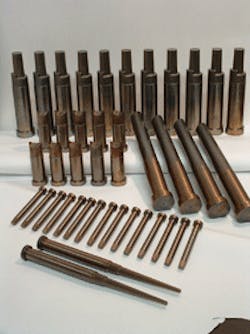Core pins treated with the MIST process demonstrated longer production runs and less maintenance because the appearance of tooling steel solder was reduced.
Molten aluminum generates significant heat that makes it corrosive and destructive to the materials it contacts. That's a fundamental problem faced by producers of aluminum diecastings. For about two years, news of an emerging technology has been spreading among diecasters and other operations that handle molten aluminum.
The talk is about the surface-conditioning technology offered by Chemical Composite Coatings Intl. L.L.C. , or C3. Most of this news has been relayed “by word of mouth,” according to C3’s Dwaine Stark, though that may change now that Metal Infusion Surface Treatment, or MIST, technology has been identified by R&D Magazine as one of the “100 most technologically significant products introduced into the marketplace in 2006.”
MIST does not merely coat a product; it “infuses” a new alloy to the surface in a nano-structured layer that creates new durability and product longevity.
Supporting C3's nomination for the award were a series of metalcasters and the North American Die Casting Assn., most of whom have realized significant benefits in process productivity, maintenance costs, and product quality thanks to the improvements in the performance and durability of their materials that contact molten metal. NADCA's director of Research, Education, & Technology Stephen P. Udvardy called the MIST process “encouraging and of high potential for providing improved die performance.”
The MIST process has been used to treat die components and inserts, and reportedly has prolonged the service life of dies and inserts as much as 40 times (see Data Summary table). MIST is also an effective treatment for metalworking tools and catalytic devices, bringing similar improvements to the jobs at hand.
Dwaine Stark explains that MIST process originated in the former Soviet Union. C3 now offers the technology exclusively, and develops the nanostructured coatings according to customers' requirements. For aluminum diecasters, Stark explains, zirconium oxide is the alloy of choice for infusion to their production materials.
C3 sought the assistance of the U.S. Dept. of Energy's Oak Ridge National Laboratories to understand more about rapid infrared heating . At ORNL, the MIST process was incorporated into research being conducted for the FreedomCar and Vehicle Technologies Program, which is identifying energy efficient, environmentally friendly highway transportation technologies. It was as a result of this research that the applications of MIST for aluminum diecasting became clear, according to the DOE lab.
At ORNL’s High Temperature Materials Laboratory, X-ray diffraction and scanning auger microanalysis (SAM) were used to characterize the MIST coatings: XRD helped to define the structure of the nanometer-scale coating; SAM analysis provided details of the coating composition from the surface to the substrate.
Now that MIST has been made available commercially, C3 develops the custom-engineered chemical treatments and performs the infusion at operations in Alpharetta, GA, and Muncie, IN. C3 also will license the process for customers to perform it at their own location, though reportedly no customers are doing so presently.
MIST is by usually described as a simple process. Once the chemical coating is applied to the die or tool, rapid infrared processing completes the “infusion.” No particularly sophisticated equipment is needed to conduct the MIST process, other than a thermal technology to raise the product temperature to 400° - 500°C. Dwaine Stark reminds that “heat is a catalytic agent,” and while there are various ways to heat the material — he identifies laser technologies and induction heating — the latter provides the thoroughness, speed, and convenience needed to infuse the desired elements to the substrate effectively. “I have never seen a simpler, more cost-effective process that is as user friendly as the C3 surface treatment,” states Dr. Jacob Stiglich of the Dept. of Metallurgical and Materials Engineering at the Colorado School of Mines.
